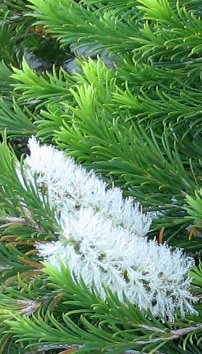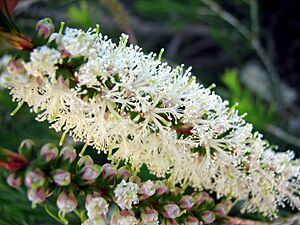Bracelet honey myrtle facts for kids
Quick facts for kids Bracelet honey myrtle |
|
|---|---|
 |
|
| M. armillaris foliage and flowers | |
| Scientific classification | |
| Genus: |
Melaleuca
|
| Species: |
armillaris
|
The Melaleuca armillaris, also known as the bracelet honey myrtle, is a plant from the myrtle family, Myrtaceae. It grows naturally in South Australia, Victoria, and Tasmania in south-eastern Australia. This tough plant is often grown because it grows fast and can be used to create a screen or windbreak. However, it can also spread easily and become a weed in some areas. It has even started growing wild in Western Australia and parts of Victoria. In nature, you can find it on coastal cliffs and near river mouths.
Contents
How to Spot the Bracelet Honey Myrtle
What Does It Look Like?
The bracelet honey myrtle can be a large bush or a small, weeping tree. It can grow up to about 8 meters (26 feet) tall. It has rough, grey bark that feels like fiber. Its branches often hang down, and it has lots of leaves.
Leaves and Branches
The leaves are arranged in a special way. They grow in pairs, with each pair at a right angle to the pair above and below it. This makes them look like they are in four neat rows along the stem. The leaves are usually between 4.5 and 19 millimeters (0.2 to 0.7 inches) long. They are narrow and oval-shaped, with a small hook at the end. They are smooth, except when they are very young.
Flowers and Fruits
The flowers are usually white, but sometimes they can be cream-colored or even a rare pink. They grow in cylinder-shaped spikes on the sides of the branches, often on older wood. These spikes can be up to 50 millimeters (2 inches) long and 25 millimeters (1 inch) wide. Each spike has many small flowers.
The petals of the flowers are small, about 1.5 to 3 millimeters (0.06 to 0.1 inches) long. They fall off as the flower gets older. The plant flowers mostly from spring to early summer. After the flowers, the plant produces woody fruits called capsules. These fruits are about 2.3 to 4.5 millimeters (0.09 to 0.18 inches) long and about 5 millimeters (0.2 inches) wide. They grow in cylinder-shaped clusters along the branches.
Where Does Its Name Come From?
History of Its Name
This plant was first officially described in 1788 by Joseph Gaertner. He used samples collected by Joseph Banks during James Cook's trip to Australia. At first, it was called Metrosideros armillaris. Later, in 1797, James Edward Smith renamed it Melaleuca armillaris.
Meaning of "Armillaris"
The second part of its name, armillaris, comes from the Latin word armilla. This word means "a bracelet." It's thought that this name was chosen because the clusters of fruits on the branches look like bracelets.
Different Types of Bracelet Honey Myrtle
There are two main types, or subspecies, of Melaleuca armillaris:
- Melaleuca armillaris subsp. armillaris: This is the most common and widespread type.
- Melaleuca armillaris subsp. akineta: This type has shorter stamens (the parts that produce pollen) and fewer flowers in its clusters.
Where Does It Grow?
Natural Homes
The subspecies armillaris grows along the coast. You can find it from the Manning River area in New South Wales down to eastern Victoria. It also grows on some islands in the Bass Strait and in the north-eastern part of Tasmania. It loves coastal headlands and clifftops, often growing in thick heathland.
Where It Has Spread
This plant has also started growing wild in other places. These include parts of Victoria, the Australian Capital Territory, southern South Australia, and the south-west of Western Australia.
Where Subspecies Akineta Lives
The subspecies akineta is only found in the Gawler Ranges of South Australia. There, it grows on rocky ridges and granite outcrops.
Growing Bracelet Honey Myrtle
People often grow Melaleuca armillaris because it grows quickly. It makes a great windbreak or a screen to block views. It's a very tough plant and can grow in most types of soil and in different sunny spots. It can handle salty sea spray, which makes it good for coastal gardens. It's also suitable for planting under power lines.
Why Is It Important?
Environmental Concerns
In some places, especially in Victoria, the bracelet honey myrtle is considered a serious environmental weed. This means it can cause problems for local plants and ecosystems. It can take over areas, replacing the plants that naturally belong there. It also increases the amount of fuel for bushfires, making areas more likely to burn. After a bushfire, the problem gets worse because the plants release many seeds, causing more to grow. This is a problem in the Mount Lofty Ranges, Adelaide Hills, and Kangaroo Island in South Australia. In Western Australia, it causes issues in coastal areas of the south-west.
Plant Eaters
The bracelet honey myrtle is a favorite food for certain insects called sawflies. One type, the long-tailed sawfly (Pterygophorus facielongus), can eat all the leaves off an entire tree very quickly.
See also
 In Spanish: Melaleuca armillaris para niños
In Spanish: Melaleuca armillaris para niños


